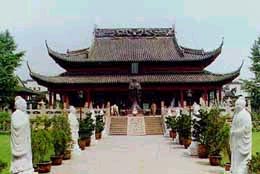 Confucius, China's legendary sage, has lost. The advocate of respect, restraint and order is now associated in Nanjingers' minds with one thing--shopping!
Confucius, China's legendary sage, has lost. The advocate of respect, restraint and order is now associated in Nanjingers' minds with one thing--shopping!
Centered around the ancient Confucius Temple (Fuzi Miao), this neighborhood in southern Nanjing is the place to be on weekends and holidays. Clothing shops and restaurants dominate the main streets (closed to vehicular traffic) while street stalls in the alleyways sell stuffed animals, plants, CDs and even more clothes. The daily night market brings these stalls out onto Gongyuan Lu, the main drag between the Confucius Temple and Pingjiang Fu Lu, a lively scene even if most of the goods on sale are simple household items. Try the yuanxiao, jelly-filled dumplings whose round shape and sweet taste symbolize happiness and harmony.
Tourists not interested in bringing a cactus and cheap hangers back home as reminders of their trip to Nanjing can load up on souvenirs at shops clustered closer to the Confucius Temple complex. In addition to the usual selection of jade goodies, teapots and paintings, vendors display yu hua shi, multicolored rocks special to Nanjing. Although some believe the colors come from Chinese blood spilled during the upheavals of Nanjing's tumultuous history that then seeped into the local rock, the more commonly accepted (and nicer) story goes that a Buddhist scholar who preached in the hills of southern Nanjing so moved the gods that they showered flowers down from the heavens in praise. Upon touching the ground, these heavenly flowers transformed into the multicolored pebbles.
With all the garish consumerism on display outside, it's little wonder that the actual Confucius Temple is the quietest place in the neighborhood. The temple was first constructed in 1034 during the Song Dynasty to complement the Jiangnan Examination School (see below), where the imperial examinations were administered. Scholars came to the temple to pray for success and demonstrate their humble respect for Confucius. Burnt down and rebuilt several times, the current structure dates from after World War Two. Its traditional sweeping eaves give the architecture a Ming and Qing flavor.
The temple's most outstanding feature is a beautiful collection of 36 jade panels detailing the Sage's life (551-479 BC)hanging on the walls of the main hall. Based on the famous set of Ming period paintings titled "Pictures of the Sage's Traces," each panel measures about two meters in height and one meter in width. These panels, however, are new, donated by a local company in 1998.
Fuzi Miao is perhaps at its best around the time of the Lantern Festival (fifteen days after the Lunar New Year), when a special exhibit of multi-sized and multi-colored lanterns themed around the twelve animals of the lunar cycle lend a festive air to the temple.
If you think that your long, cramped flight to China was some form of torture, a visit to the Exhibition of the History of the Jiangnan Examination School (Jiangnan Gongyuan), should set your mind at ease. Founded in 1168 (the Song Dynasty), the school was used to administer the rigorous civil service exams used to choose officials during China's imperial age. At the height of its prosperity, the complex contained 20,644 examination cells, each just one square meter in area. Candidates spent a total of nine days in their cell--the wooden desk plank turned into a bed at night--without the freedom to leave. Success was rare as only 200 of the 20,000 candidates passed.
The modern exhibit contains forty examination cells plus a small museum that claims to be the only specialized museum in China dedicated to the imperial examination system. Unfortunately, all the explanations are in Chinese. The exhibit is a short walk east of the Confucius Temple at 1 Jinling Lu.
How to Get There:There are several ways to approach the Fuzi Miao neighborhood. From the north (Xinjiekou, Gulou), the main entrance is at the intersection of Taiping Nan Lu and Jian Kang Lu. Bus number one terminates here. From the west, enter from Zhonghua Lu (buses 2, 16, 26, 33) and then walk east along Zhanyuan Lu. Alternately, take a taxi to "Fuzi Miao" this should cost approximately RMB 10-15 and take about 10 minutes.
Confucius Temple
Tel: 025 - 662-8639
Open Time: 8:00?21:00
Admission Price: 12 yuan (US$1.5)
Website: http://www.njfzm.com/fzmen/index.htm
Jiangnan Examination School
Tel: 025 - 662-6556
Open Time: 8:00 - 18:00
Admission: 8 yuan (US$1)
(china.org.cn February 25, 2003)
|

